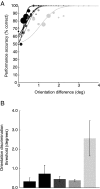Cross-orientation suppression in human visual cortex
- PMID: 21775720
- PMCID: PMC3214101
- DOI: 10.1152/jn.00540.2011
Cross-orientation suppression in human visual cortex
Abstract
Cross-orientation suppression was measured in human primary visual cortex (V1) to test the normalization model. Subjects viewed vertical target gratings (of varying contrasts) with or without a superimposed horizontal mask grating (fixed contrast). We used functional magnetic resonance imaging (fMRI) to measure the activity in each of several hypothetical channels (corresponding to subpopulations of neurons) with different orientation tunings and fit these orientation-selective responses with the normalization model. For the V1 channel maximally tuned to the target orientation, responses increased with target contrast but were suppressed when the horizontal mask was added, evident as a shift in the contrast gain of this channel's responses. For the channel maximally tuned to the mask orientation, a constant baseline response was evoked for all target contrasts when the mask was absent; responses decreased with increasing target contrast when the mask was present. The normalization model provided a good fit to the contrast-response functions with and without the mask. In a control experiment, the target and mask presentations were temporally interleaved, and we found no shift in contrast gain, i.e., no evidence for suppression. We conclude that the normalization model can explain cross-orientation suppression in human visual cortex. The approach adopted here can be applied broadly to infer, simultaneously, the responses of several subpopulations of neurons in the human brain that span particular stimulus or feature spaces, and characterize their interactions. In addition, it allows us to investigate how stimuli are represented by the inferred activity of entire neural populations.
Figures









References
-
- Carandini M, Heeger DJ. Summation and division by neurons in primate visual cortex. Science 264: 1333–1336, 1994 - PubMed
Publication types
MeSH terms
Grants and funding
LinkOut - more resources
Full Text Sources

